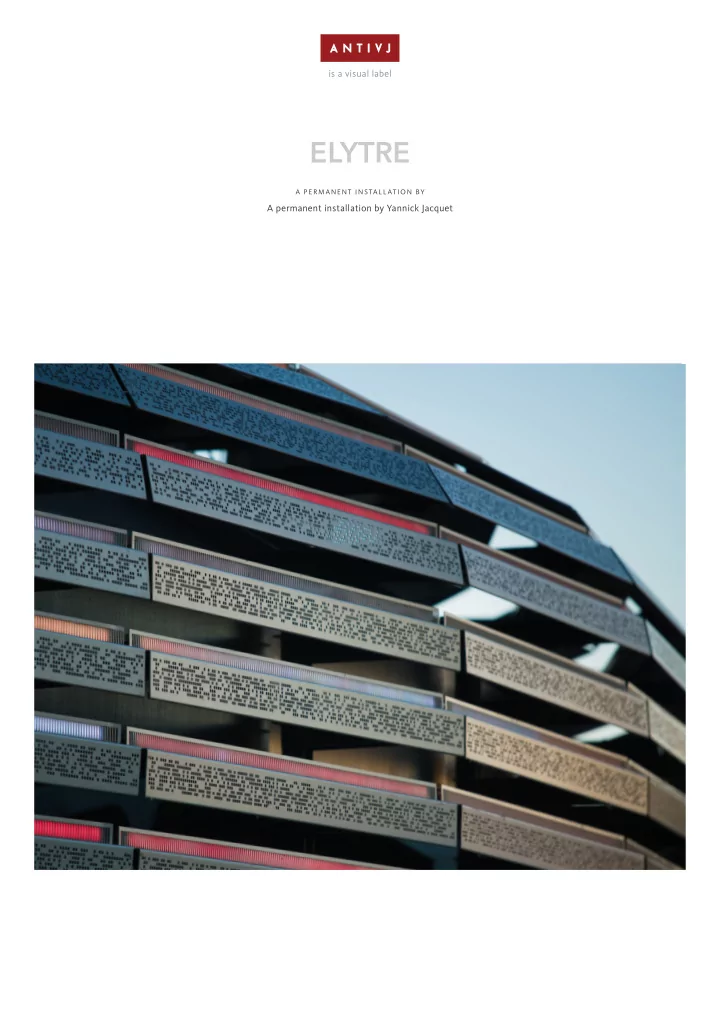

is a visual label ELYTRE A PERMANENT INSTALLATION BY A permanent installation by Yannick Jacquet
I N T R O ELYTRE A PERMAMENT INSTALLATION BY Yannick Jacquet It has taken the Franco-Swiss artist and videographer Yannick Jacquet three years to create Élytre , a forty-metre- long generative work on display at the foot of the the Alexandre III bridge in Paris. The piece was commissioned as a permanent design feature for Le Flow, a fmoating building moored along the new pedestrian area on the banks of the Seine. Yannick Jacquet drew inspiration from the dark mass of the barge between the sky and the river to fjne-tune his response to the immediate surroundings, calling on the instability and permanence of the fmowing water, the infjnitely nuanced shifts of light, and the interplay of transparencies between its large plate-glass windows and the glass dome of the Grand Palais just across the water. Drawing on the barge’s organic, cocoon-like architecture, he came up with a highly sensitive, reactive work in the form of an installation that reverses the overall structural inertia of the barge’s four hundred tons of steel, as if echoing Reyner Banham’s principle of regenerative architecture. The installation is linked up to a battery of sensors so that it varies according to the time of year, season, atmospheric pressure, wind speed, temperature, and so on. It is in a constant state of fmux, permanently subject to imperceptible shifts.
I N T R O As a generative work, it has its own dedicated, custom made software programme and required the artist to work closely with a team of specialists in engineering, craft manufacture, electronics, programming, and architecture. As night falls, the work softly rises up into the surrounding cityscape. The impression on the viewer’s retinas is deep and lasting. The colourful stimuli of elements emerging and fading seem to mirror the shimmering river and foliage and mimic the circadian rhythm of breathing. The artist also devoted considerable research to the issue of colour. A metal mesh with its own unique structure is fastened over the cladding from the roof to the hull, creating a pointillist efgect by means of an infjnite palette of pixels. The material resists the quantity of light and contrast: the artist has sought to create nuances and shadings of colour by pushing LEDs beyond their usual capacities. Yannick Jacquet explains that the installation is part of a broader project exploring cycles and our relationship with time. The work is designed less as an invitation to a journey as an order to slow down. To take the time for contemplation. Video teaser: antivj.com/elytre Making of: antivj.com/elytre Photos: antivj.com/press/elytre Vimeo channel: vimeo.com/channels/antivj
Elytre, Y.Jacquet / Alexander III bridge, Paris / F
Elytre, Y.Jacquet / Alexander III bridge, Paris / F
Elytre, Y.Jacquet / Alexander III bridge, Paris / F
Elytre, Y.Jacquet / Alexander III bridge, Paris / F
B I O G R A P H Y Yannick Jacquet Yannick Jacquet has spent ten years developing an visual arts project exploring how to reverse the deterioration inherent in our exchanges with the world. His process of visual creation draws on structural elements as disparate as the architecture of the Centre Pompidou Metz and a Ravel string quartet. While the precise stratagem may vary, from the spectacular to the intimate, each undertaking is always rooted in the concept of resilience. This is art haunted by a discourse on the end of time. Jacquet makes no mystery of it. He invokes parallels with the Belgian artist Berlinde de Bruyckere’s work on mutations in living matter, the Japanese Ryoichi Kurokawa’s stellar visions, and his fellow Swiss artist Jean Tinguely’s sardonic laugh and his 1960s machines designed to self destruct. The installation Mécaniques Discursives, created in 2013 in collaboration with the artist and engraver Fred Penelle, is something of an artist’s manifesto. A step in the dark. Sonar, alarms, and radio frequencies resonate in the shifting glow of vectorial impulses and cut out silhouettes that reference pop culture. Yet the experience challenges expectations. The electronic signals lead nowhere. The sounds and fjgures have no referent beyond themselves. The message fails in transmission. Yannick Jacquet developed a subtle kinaesthetic method that strips the viewer of his conditioning via an immersive process. 2016 has seen the creation of the generative work Flow on a fmoating building at the foot of the Alexandre III bridge in Paris. Jacquet’s twofold research into colour and the notions of time and natural cycles has led him to fmesh out a new paradigm: slowness. Slowness as one possible path to the urgently needed restoration of sensibility. Y A N N I C K J A C Q U E T . N E T
C O N T A C T Nicolas Boritch hello@antivj.com +32 (0)494 540 951 (BE) 30 quai des charbonnages 1080 Bruxelles ANTIVJ is a European visual label representing, producing and promo- ting the work of artists whose practice spans from site-specific to instal- lation work, large-scale to intimate, from live performance to scenogra- phy, software to hardware development, often as a response to place & space, light & architecture, code & motion. Focused on exploring new formats of experience and experimenting with new forms of narrative the label has been recognized for having experience at developing and delivering work that don’t exist, and put- ting a strong attention to details. These works have been commissioned and presented at Centre Pompi- dou Metz, Sundance festival, Seoul M-museum, Nemo Biennale Paris, Rome’s Macro, CMoDA Beijing, Empac NY and Taiwan museum of fine arts. Since 2007, ANTIVJ has produced, managed and toured work by artists such as Yannick Jacquet, Olivier Ratsi, Simon Geilfus, Xavier Chassaing, Joanie Lemercier and Romain Tardy; and composers such as Thomas Va- quié, Murcof, Dopplereffekt, Flying Lotus and Laurent Delforge. www.antivj.com
Recommend
More recommend